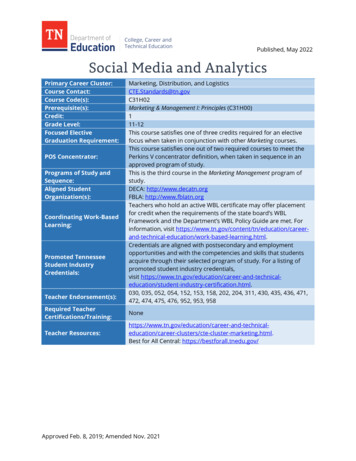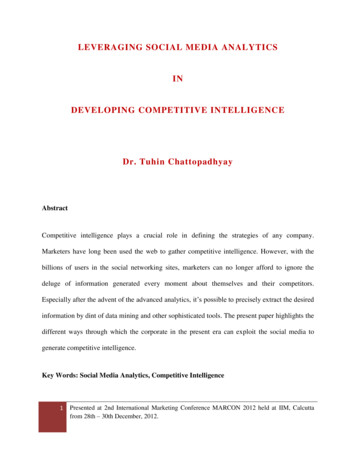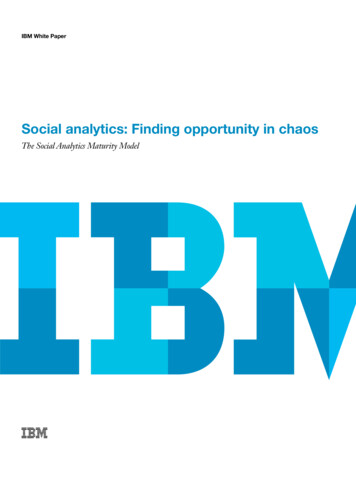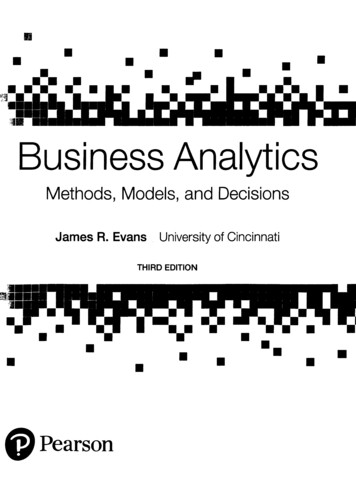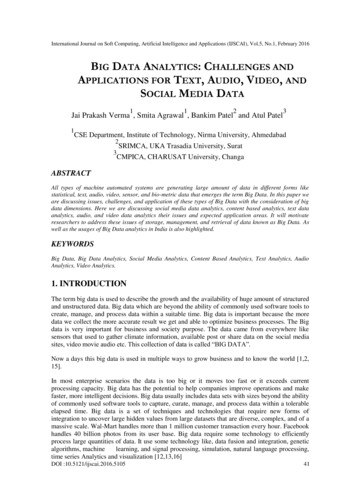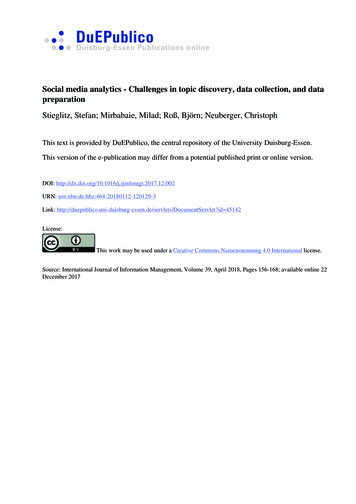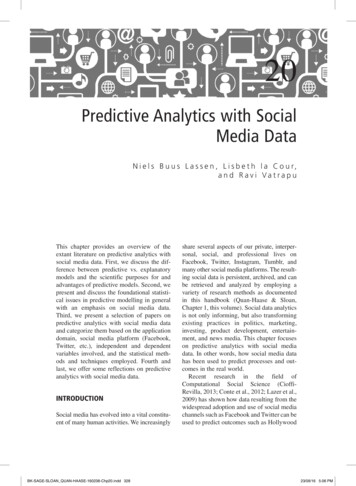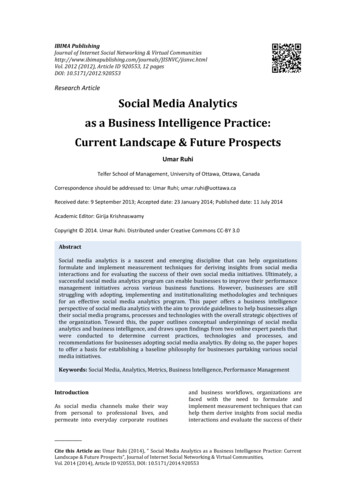
Transcription
IBIMA PublishingJournal of Internet Social Networking & Virtual /JISNVC/jisnvc.htmlVol. 2012 (2012), Article ID 920553, 12 pagesDOI: 10.5171/2012.920553Research ArticleSocial Media Analyticsas a Business Intelligence Practice:Current Landscape & Future ProspectsUmar RuhiTelfer School of Management, University of Ottawa, Ottawa, CanadaCorrespondence should be addressed to: Umar Ruhi; umar.ruhi@uottawa.caReceived date: 9 September 2013; Accepted date: 23 January 2014; Published date: 11 July 2014Academic Editor: Girija KrishnaswamyCopyright 2014. Umar Ruhi. Distributed under Creative Commons CC-BY 3.0AbstractSocial media analytics is a nascent and emerging discipline that can help organizationsformulate and implement measurement techniques for deriving insights from social mediainteractions and for evaluating the success of their own social media initiatives. Ultimately, asuccessful social media analytics program can enable businesses to improve their performancemanagement initiatives across various business functions. However, businesses are stillstruggling with adopting, implementing and institutionalizing methodologies and techniquesfor an effective social media analytics program. This paper offers a business intelligenceperspective of social media analytics with the aim to provide guidelines to help businesses aligntheir social media programs, processes and technologies with the overall strategic objectives ofthe organization. Toward this, the paper outlines conceptual underpinnings of social mediaanalytics and business intelligence, and draws upon findings from two online expert panels thatwere conducted to determine current practices, technologies and processes, andrecommendations for businesses adopting social media analytics. By doing so, the paper hopesto offer a basis for establishing a baseline philosophy for businesses partaking various socialmedia initiatives.Keywords: Social Media, Analytics, Metrics, Business Intelligence, Performance ManagementIntroductionAs social media channels make their wayfrom personal to professional lives, andpermeate into everyday corporate routinesand business workflows, organizations arefaced with the need to formulate andimplement measurement techniques that canhelp them derive insights from social mediainteractions and evaluate the success of theirCite this Article as: Umar Ruhi (2014), " Social Media Analytics as a Business Intelligence Practice: CurrentLandscape & Future Prospects", Journal of Internet Social Networking & Virtual Communities,Vol. 2014 (2014), Article ID 920553, DOI: 10.5171/2014.920553
Journal of Internet Social Networking & Virtual Communities2own social media initiatives. Social mediaanalytics is a nascent and emerging fieldpoised to enable such an undertaking –allowing businesses to improve theirperformance management initiatives acrossvarious business functions. Whether it is tomeasure the effectiveness of promotionalcampaigns, gather insights about customerneeds and preferences, discern brandperceptions, obtain feedback on productperformance, or to capture data on markettrends, social media analytics have thepotential to provide useful information tovarious lines of business such as marketingand sales, customer relations, publicrelations and product development.Despite these recognized benefits and thewide range of vendor offerings andtechnology capabilities in the social mediaanalytics space, businesses are still lizingmethodologiesandtechniques for an effective social mediaanalytics program (Owyang, 2011; Petrocelli,2013). This paper addresses this issue byadvancing the viewpoint that social mediaanalytics need to be positioned as a businessintelligence practice – tying its variousmonitoring, discovery and predictivecapabilities to the tactical execution of socialmedia initiatives and to high level strategicobjectives of the organization.In terms of organization, this paper firstprovides conceptual definitions of socialmedia and social media analytics. This isfollowed by examples of contemporarybusiness use-cases and metrics constitutingsocial media analytics practices. Next, thepositioning of social media analyticsprograms within the realm of anorganization’s business intelligence practiceis elaborated. The paper concludes withqualitative research findings from two recentexpert panel sessions. The findings arepresented in the form of five key takeawaysrelated to the current landscape for socialmedia analytics, as well as guidelines forfirmslookingatadoptingvarioustechnologies and processes to enable socialmedia analytics in their organization.Conceptual FoundationFrom SocialAnalyticsMediatoSocialMediaBefore discussing the scope and specifics ofsocial media analytics, it is important toclarify what is included in our definition ofsocial media, as there is no hard-and-fastdefinition of the term that everyone agreesupon (Kaplan & Haenlein, 2010), and theterm has often been misused as a buzzword(Kietzmann,Hermkens,McCarthy,&Silvestre, 2011). Notwithstanding the lack ofa standard definition, most academics andpractitioners use the term social media todescribe a variety of online channels andplatforms that can facilitate collaborativecreation and dissemination of information.Common descriptive features of social ve, shared, social network andrapid information dissemination (Kaplan &Haenlein, 2010). Categories of social mediadefined by Sterne (2010) include thefollowing: forums and message boards,review and opinion sites, social networks,blogging, microblogging, bookmarking, andmedia sharing.Central to the social media, categories listedabove are two concepts that differentiatethese channels and platforms from othertraditional technologies for computermediated communication – namely, activitystreams and social graphs (Hinchcliffe, Kim,& Dachis, 2012). Social media behaviors suchas communicating, creating, sharing andcollaborating constitute the activity streamsofindividuals.Furthermore,theseinteractions occur within the context of tiesand relationships among individuals andtheir social network of friends, followers andfans – representing their social graph ofconnections.These ideas of activity streams and socialgraphs are also significant in the context ofsocial media measurement as they providethe basis for quantifying and evaluatingactions and responses that spawn contentUmar Ruhi (2014), Journal of Internet Social Networking & Virtual Communities,DOI: 10.5171/2014. 920553
3Journal of Internet Social Networking & Virtual Communitiesand conversations on social media platformsand channels. These baseline activity metricsat a granular level can subsequently be usedto develop advanced measurement models ina company’s social analytics initiatives – thesubject of discussion in the next sections ofthis paper.Working DefinitionAnalyticsofSocialMediaConsistent with the business intelligenceperspective of social media analytics adoptedin this paper, we adopt the following workingdefinition of social media analytics asproposed by Lovett (2011): “Social Analyticsis the discipline that helps companiesmeasure,assess,andexplaintheperformance of social media initiatives in thecontext of specific business objectives”. Thisdefinition highlights the relevance of socialmedia analytics to performance managementand business objectives – constructs thatdefine the very notion of businessintelligence (Lonnqvist & Pirttimaki, 2006;Watson & Wixom, 2007).At its core, social media analytics comprisesthe practice of defining and adopting theright metrics for measuring the success ofsocial media initiatives in organizations. It isa measurement framework that facilitates anintegrated viewpoint of an measures at an operational level, and varioussocial media metrics that can be tied to thoseperformance measures.For purposes of this discussion, wedifferentiate between social media metricsand analytics by situating the latter as ahigher-order construct. This viewpoint isconsistent with that of other researchers andpractitioners (Carlson & Kavanagh, 2011;Sterne, 2010). While metrics are primarilyconcerned with data, transactions andinformation from the past, analytics on theother hand draw upon and analyze thosemetrics to generate insights and informfuture strategy. For example, Lovett (2011)proposes a multi-level hierarchy of socialmedia measures ranging from countingmetrics to foundational metrics, outcomemetrics and business value metrics – eachlevel building on top of the other, andtogether they constitute a social mediaanalytics program. It should be emphasizedthough, that actionable analytics requirewell-designed metrics, and without the rightset of descriptive measurements at anoperational level, organizations won’t be ableto discover patterns and gain insights foreffective business strategy.Common Use-Cases & Performance Metricsfor Social Media AnalyticsWhile specific features and capabilities ofsocial media analytics solutions vary a greatdeal among vendors, most software providessupport for standard use-cases that applyacross a wide range of businesses.Algorithms based on social network analysis,natural language processing, complex eventprocessing, and data mining techniques arecommonly utilized by social media analyticssoftware to offer a range of analysiscapabilities and metrics that can be used bymanagers for deriving critical businessinsights, and to facilitate effective decisionmaking (Melville et al., 2009; Luckham,2011).On the outset, many analysts agree thatbusinesses often use social media analyticsfor a few common reasons. The mainbusiness drivers for social media s;understandingsentiment;identifying audience segments; measuringbrand reputation and share of voice; anddetermining effectiveness of marketingmessages (Lovett, 2011; Petrocelli, 2013;Stodder, 2012). More recently, there has alsobeen an emphasis on including predictiveanalysis capabilities in social analyticssoftware to allow businesses to discoverpatterns and anticipate impacts of currentmetrics, such as sentiment on future socialmedia activities (Petrocelli, 2013; Stodder,2012).Umar Ruhi (2014), Journal of Internet Social Networking & Virtual Communities,DOI: 10.5171/2014. 920553
Journal of Internet Social Networking & Virtual Communities4Table 1 below summarizes some commonuse-cases and the underlying questions thatbusinesses want to answer through socialmedia analytics, along with analysistechniques that enable these use-cases andsample metrics that may be of interest tomanagement.As highlighted in the Table 1, effective socialmediameasurementcomprisesacombination of metrics derived throughmultiple analysis techniques, and multiplemetrics need to be weaved together in orderto extract meaning and insights that arerelevant to the business. Also, the complexityof analysis techniques varies by the contextof business and the scope of tactical orstrategic insights desired. A holistic socialmedia analytics program should ideallyincorporate multiple use-cases that canenable monitoring, discovery and predictivecapabilities to be utilized in the decisionmaking process.Table 1: Objectives, Requirements & Outcomes in Social Media AnalyticsCommon Use-Cases for RequiredSocial Media AnalyticsBusiness InsightEnablingSocialPertinent Social MediaMediaAnalyticsPerformance MetricsTechniquesSocialAudienceSegmentationWhich segments totarget for acquisition,Mediagrowth or retention?SocialWho are the advocates Analysisandinfluencesforbrand or product?SocialInformationDiscoveryWhat are the new oremergingbusinessMediarelevanttopicsorthemes?Are new communities ofinfluence emerging?What are the alMediacompareagainstExposure & Impactcompetitors?Which social mediachannels are being usedfor discussion?SocialBehaviorInferencesWhat is the relationshipamongbusinessMedia relevant topics andissues?What are the causes forexpressed intent (buy,churn etc.)?NetworkActive AdvocatesAdvocate InfluenceNatural LanguageTopic TrendsProcessingSentiment RatioComplexEventProcessingConversation ReachSocialNetworkVelocityAnalysisShare of VoiceNatural LanguageAudience EngagementProcessingNatural LanguageProcessingClusteringDataMiningUmar Ruhi (2014), Journal of Internet Social Networking & Virtual Communities,DOI: 10.5171/2014. 920553InterestsorPreferences (Theme)CorrelationsTopic Affinity Matrices
5Journal of Internet Social Networking & Virtual CommunitiesAs outlined in Table 1, there are variousoptions available to organizations forimplementing and institutionalizing theirsocial media analytics programs. What isimportant is for social media analytics to beapproached as a discipline that transcendsjust technology tools and applications. Itshould be considered as a practice and aprocess that can enable businesses to usesocial data as a crucial input into businessdecisions and strategy. Towards this, socialmedia analytics needs to be situated andintegrated as part of the overall businessintelligence practice in the organization. Thenext section provides an overview of therequirements and benefits for adopting suchan orientation for social media analytics.Social Media Analytics As a BusinessIntelligence PracticeFor the purposes of this paper, we adopt abusiness intelligence (BI) perspective ofsocial media analytics. In positioning a socialmedia analytics program as part of anorganization’s business intelligence practice,we adhere to the notion that BI can beconceptualized as both, a process and aproduct (Jourdan et al., 2008). As a process,BI comprises methods and procedures thatorganizations can use to acquire, analyze anddisseminate information for businessdecision-making (Lonnqvist & Pirttimaki,2006), and develop useful intelligence to helpthem compete and grow in their industry(Jourdan et al., 2008). The product viewpointof BI focuses on the resulting informationfrom analytical procedures that can alloworganizations to predict the behavior ofvarious stakeholders and industry playerswithin their business environment (Vedderet al., 1999). Overall, the practice of BIpertains to making effective use ofinformation technology to deliver actionableinformation for decision-makers (Negash,2004; Watson & Wixom, 2007).Core to the practice of BI is the integrationbetween business objectives at the strategylevel and key performance indicators (KPIs)at the operational level. KPIs are metrics thatare central to the well-being of anorganization, and can be used directly tomeasure or evaluate the success of achievingthe business objectives, and to prescribe acourse of action (Lonnqvist & Pirttimaki,2006; Watson & Wixom, 2007).Recent research on social media analytics hasemphasized the need to adopt a BI basedapproach to collecting, analyzing andinterpreting social media data (Heijnen et al.,2013; Murdough, 2009). In practicing socialmedia analytics as a business intelligenceinitiative, it is important that every socialmedia metric tie to a business metric or KPI(key performance indicator), which in turnshould map to a strategic business objective.For example, it is often recommended thatsocial media measurement initiatives beinstigated through a high-level considerationof business objectives common to allorganizations – raising revenue, loweringcosts, or improving customer satisfaction(Sterne, 2010). Similarly, for social mediamarketing initiatives, the high-level goals areusually tied to brand awareness, leadgeneration and customer retention (Kelly,2012). Etlinger et al. (2013) emphasize thatbusiness goals can often act as the North Starfor businesses, hence helping them formulateandprioritizetheirsocialmediameasurement initiatives.Overall, the relationship between corporateobjectives, supporting business unit metricsor KPIs and social media metrics should beidentifiable. Early efforts in defining andelaborating these relationships can helpprovide a strong foundation for a socialmedia analytics program in the organization(Lovett, 2011; Zeng et al., 2010). Owyang etal. (2010) refer to this exercise as “creating asocial media measurement playbook” thataligns an organization on the goals,objectives, expectations and actions of itssocial media initiatives.Figure 1 below depicts the relationshipsamong strategy, management and executionlevels in the organization. We provide theUmar Ruhi (2014), Journal of Internet Social Networking & Virtual Communities,DOI: 10.5171/2014. 920553
Journal of Internet Social Networking & Virtual Communities6following simple example to illustrate theconfiguration and relationships between thethree levels shown in the figure. Towardsmeeting the high-level business objective ofimproving customer satisfaction, fosteringdialog with clients may be a specific businessobjectiveforcustomerrelationshipmanagement at the strategy level. Amongother KPIs that can be used to track theeffectiveness in meeting this objective at themanagement level, the organization may usea metric such as conversation reach(Interactive Advertising Bureau, 2009). Atthe execution level, such a metric can becalculated by looking at the ratio between thenumber of people participating in theconversation and the number of peopleexposed to the conversation (Owyang et al.,2010).Figure 1: Business Intelligence Components in a Social Media Analytics ProgramIn deliberating social media analyticsthrough a BI lens, it is recommended that inaddition to simply defining operationalmetrics to strategic KPIs, organizations alsoestablish benchmarks at the levels of KPIsand social media metrics. Such an orientationcan spell the difference between success andfailure of a social media measurementinitiative (Fisher, 2009; Murdough, 2009),and it also indicates the maturity of socialbusiness intelligence practices and processesin the organization (Etlinger et al., 2013).Continuing with the example cited above,metrics such as conversation reach shouldideally not just be reported as an absolutemetric, but also as a trend over time, or as acomparative indicator against previous orexternal benchmark. This will help theorganization gain a sense of whether thevolume of participants in their conversationsis expanding, and whether the conversationsare spreading beyond their regular dialogvenues.The preceding sections in this paper haveoutlined the author’s perspective of socialmedia analytics including conceptualunderpinnings as well as suggestedorientation for businesses. In order toexpand upon some of these guidelines andoffer further insights, the next sections in thepaper discuss the findings and results fromtwo expert panels that were conducted togain an understanding of the current stateand future prospects of social mediaanalytics.Expert Insights & RecommendationsMethodologyQualitative data for this study was collectedthrough two online expert panel sessionsconsisting of 11 participants in total (six inthe first session and five in the second). Theparticipants who were invited to assist withthis research were selected as experts in thefield of social media analytics by virtue ofUmar Ruhi (2014), Journal of Internet Social Networking & Virtual Communities,DOI: 10.5171/2014. 920553
7Journal of Internet Social Networking & Virtual Communitiestheir industry experience. They wereapproached and recruited through onlinediscussion forums and practice groups onsocial networking sites related to nts had multiple years of strategicand operational-level exposure to socialmedia analytics through their workplace orconsultingbackgrounds,andthreeparticipants were currently leading theirown consulting practices related toenterprise social media.The online panel sessions were facilitatedthrough a hosted solution providing groupsupportsystem(GSS)functionalityi.Researchers have suggested GSS tools to be auseful technology aid in scenario planningand strategy development (Bryson, 1997;Eden & Ackermann, 1999) . Through thevarious features available in the GSS, wewere able to use a mixture of structured andunstructured mechanisms for data collectionin our expert panel sessions. We consistentlyutilized the nominal group technique(Delbecq & Van de Ven, 1971; Sample, 1984)which allowed participants to create theirown list of ideas and submit them for furtherdiscussion at their own discretion. Thenominal group technique is a structuredvariation of small group discussion methods,and prevents the domination of discussion bya single person, encourages the more passivegroup members to participate, and results inaset ofprioritized solutionsorrecommendations (Boddy, 2012; Bryson,1997; Sutton & Arnold, 2011).In our online expert panel sessions, thenominal group technique was used in astructured question and answer sessionformat to gather information fromparticipants about the current state of socialmedia analytics, issues and challenges forfirms, and recommendations for effectivesocial media analytics strategy. Each onlineGSS session consisted of multiple rounds ofinteractionsduringwhichpanelistsproposed, rated, commented, reviewed, andre-rated items related to these topics andrelated issues.FindingsThe results from the online expert panelsession were compiled and summarized intovarious themes that the participantshighlighted as important with respect to thecurrent landscape for social media analytics,as well as guidelines for firms looking atadopting various technologies and processesto enable social media analytics in theirorganization. The key take-aways from thesethemes are reported in the followingsubsections.Current State of Social Media Analytics:Lack of Business StrategyAll expert respondents in our panel agreedthat as a business practice, social mediaanalytics is still in its infancy. Organizationsneed to put a concerted effort inunderstanding the potential for using socialmedia metrics and analytics in the context oftheir business, in defining their businessobjectives and requirements for utilizingvarious social media measurements, and increating an effective implementation strategyfor delivering social media analytics as partof day-to-day business intelligence.One expert compared the current state ofsocial media analytics to the state of WorldWide Web (www) in 1995 when only fewcompanies were putting in serious efforts,and most organizations were “merelyinterested in conversations about it”.Several participants also reiterated thatorganizations need to understand the valuethat social media analytics can bring in theworkflows of many business functions, andthis might require various cycles of usage,trial and error, and learning lessons.Development of mainstream social mediaanalytics solutions is dependent onbusinesses identifying their primary usecases for social media, testing various tools toenable these use-cases, and mapping the usecases to business objectives and keyperformance indicators.Umar Ruhi (2014), Journal of Internet Social Networking & Virtual Communities,DOI: 10.5171/2014. 920553
Journal of Internet Social Networking & Virtual Communities8Most participants agreed that with respect tocurrent solutions in the marketplace, there isno dearth of options (free and paid), and avarietyofanalyticsplatformsandapplications can potentially be utilized byorganizations. However, organizations needto spend some time in figuring out whichtools provide the intelligence that is alignedwith measurements for desired outcomes oftheir social media initiatives.Social Media Metrics: Select Few PopularChoices & Standards Still MissingAlmost all panelists agreed that currentsoftware suites focus on providing selectmainstream social media metrics such asengagement, reach, influence, and sentiment,and businesses have largely been unable toadequately link these and other metrics withkey performance indicators for their businessobjectives. For instance, many businesses arestill trying to establish a plausible linkbetween social media activity on theirchannels and their sales revenue.Specifically, the panelists highlighted thatengagement and reach metrics for socialmedia are typically used by manyorganizations as a starting point for severalreasons. Firstly, marketing professionals whohave previously worked with digitalmarketing campaigns can identify withmetrics such as page views, unique visitors,return visits, interaction rate etc. which arecommonly reported in social media analyticssoftwareinsimilarandeasilyunderstandable terms such as number of fansor followers, number of posts or tweets etc.Linking these metrics to ROI is relativelyeasier than other more complex andmultidimensionalanalytics.Panelparticipants suggested that organizationsusing these metrics while being mindful ofthe differences between social mediachannels and traditional websites. Severalparticipants also pointed out to theusefulness of the IAB categorization of socialmedia platforms and relevant metrics forthose platforms (Interactive AdvertisingBureau, 2009), and recommended its use toorganizations getting started with their socialmedia measurement initiatives.With respect to advanced social mediametrics such as sentiment and influence, thepanelistshighlightedproblemsandchallenges with measuring these compositemetrics. Some panelists commented thatmost algorithms for sentiment analysis areonly accurate in the 60% - 70% range, asmost software cannot account for detailedcues for sarcasm, context or slang. Otherparticipants agreed and noted that sentimentanalysis should primarily be used to gaugethe main themes of discussions surroundinga brand, product or service. Similarly withrespect to influence metrics, demonstratingcause and effect between individual actionsand aggregated outcomes is problematic,and most measurement programs cannotreliably link social media actions to KPIs suchas conversion rates in the consumer buyingcycle. Most evidence is based on anecdotes,and this withholds the objectivity of anydecisions based on influence analysis.All panelists agreed that a social mediaanalytics program in an organization cannotflourish until the industry agrees uponstandard definitions for underlying socialmedia metrics. Until such a time,organizations can focus on definingconsistent internal measurements to reportthe performance of their social mediainitiatives, but be cautious in trying to inferfrom cross-company comparisons based onthose numbers.Social Media MeasurementElephant in the Room: ROIandtheAlmost all expert panelists acknowledgedthat return on investment (ROI) remains thekey question for social media analyticsprograms, and that the question keepsgetting asked because organizations haven’tyet found a satisfying answer. Specifically,executive level management is verypersistent in their demand for social mediameasurements to uncover and define the ROIUmar Ruhi (2014), Journal of Internet Social Networking & Virtual Communities,DOI: 10.5171/2014. 920553
9Journal of Internet Social Networking & Virtual Communitiesof social initiatives in the form of revenue,profits or sales.Future of Social Media Analytics: Advancesthrough Big Data & Predictive AnalyticsSome panelists also indicated that somemarketing professionals are experimentingand redefining ROI in terms of social mediaspecific outcomes. For example, someprovidersandconsultantshaverecommended the use of Return on Influenceor Return on Engagement as being moreappropriate in the context of social media.However, panel participants concurred thateven these new metrics remained “hazy” and“vague” since there isn’t an agreed upondefinition. As follow-up comments in thediscussion, most participants assented thatthere currently isn’t a definitive method tomeasure ROI – in fact the metric may beconceptualized dissimilarly by differentbusinesses. Therefore, it might be useful forbusinesses to develop their performancedashboards to show ROI from more than oneperspective.The panelists in both online expert sessionsagreed that the future of social mediaanalytics is closely tied to the exploitation ofbig data and the emergent field of datascience. With unprecedented access to dataand computational ability, businesses willfinally be able to tap in the abundantstructured data in their internal enterprisesystems, as well as continuously use socialmediamonitoringtoolstoscrapeunstructured data from the social web. Socialnetworking sites like Facebook are buildingdata centers around the world to collect andprocess data related to their members’ digitalfootprints which can potentially be used toaid business decision-making processes –especially in areas related to marketing andbrand management. The key, according toexpert panelists, would be to effectivelyutilize big data by overcoming its fragmentednature and by reassembling relevantinformation and integrating it with otherinternal sources of data in a time sensitivefashion in order to facilitate ations will need to find effective waysto cull signal from noise and identify the mostvaluable data and metrics for their business.Only then can businesses work towards aneffective analytics program to providestrategic insights.Value Driver for Social Media Analytics:Integrated Business Process WorkflowsMany panelists repeatedly spoke about theimportance and potential of integratedenterprise systems and business processworkflows. In order to reap value from socialmedia analytics, organizations need to enableand support business intelligence workflowsthrough the integration of internal data fromenterprise systems such as customerrelationship management (CRM) with theirsocial listening platforms. With reference toCRM specifically, it was noted that allapplications that touch the customer shouldideally have a social media component.Additionally, organizations sh
provides conceptual definitions of social media and social media analytics. This is followed by examples of contemporary business use-cases and metrics constituting social media analytics practices. Next, the positioning of social media analytics programs within the realm of an organization's business intelligence practice



